HR Strategies for Tourism Sustainability: Addressing Key Org Factors
VerifiedAdded on 2023/06/04
|6
|1335
|204
Report
AI Summary
This report analyzes the impact of organizational factors on the financial performance and sustainability of tourism companies, emphasizing the critical role of the Human Resource Department in mitigating these factors. It discusses the importance of liquidity management through optimal staffing levels and the impact of firm size on profitability, highlighting the need for skilled professionals and a positive working environment to maximize employee productivity. Furthermore, the report addresses economic factors, focusing on enhancing labor productivity through technical improvements, better management practices, and structural changes in production. It underscores the significance of measuring employee performance, fostering staff development, and providing appropriate incentives to boost efficiency and achieve organizational objectives. The report concludes by emphasizing that increasing labor productivity is essential for improving output, quality, and overall profitability, and Desklib provides additional resources for students.
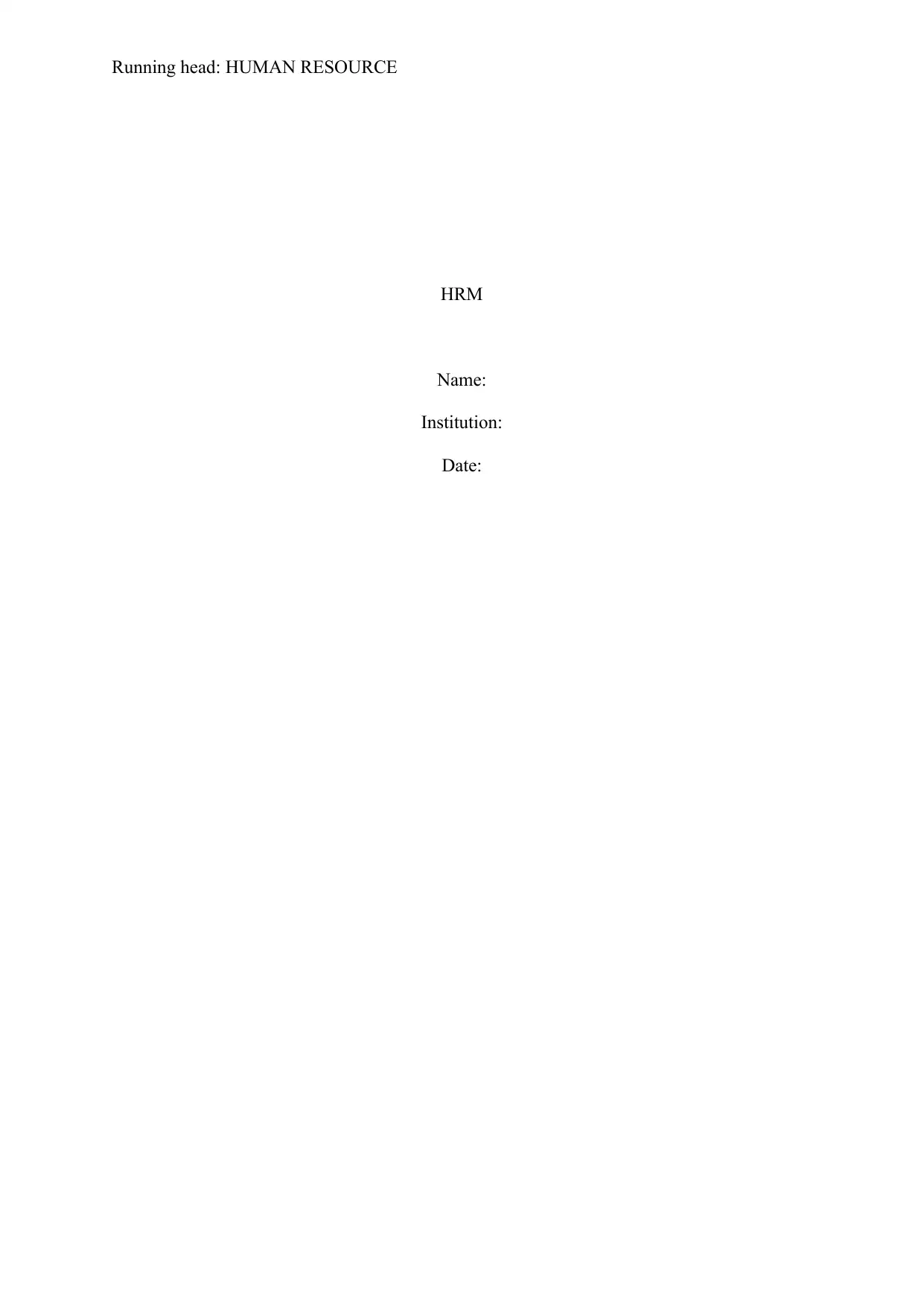
Running head: HUMAN RESOURCE
HRM
Name:
Institution:
Date:
HRM
Name:
Institution:
Date:
Paraphrase This Document
Need a fresh take? Get an instant paraphrase of this document with our AI Paraphraser
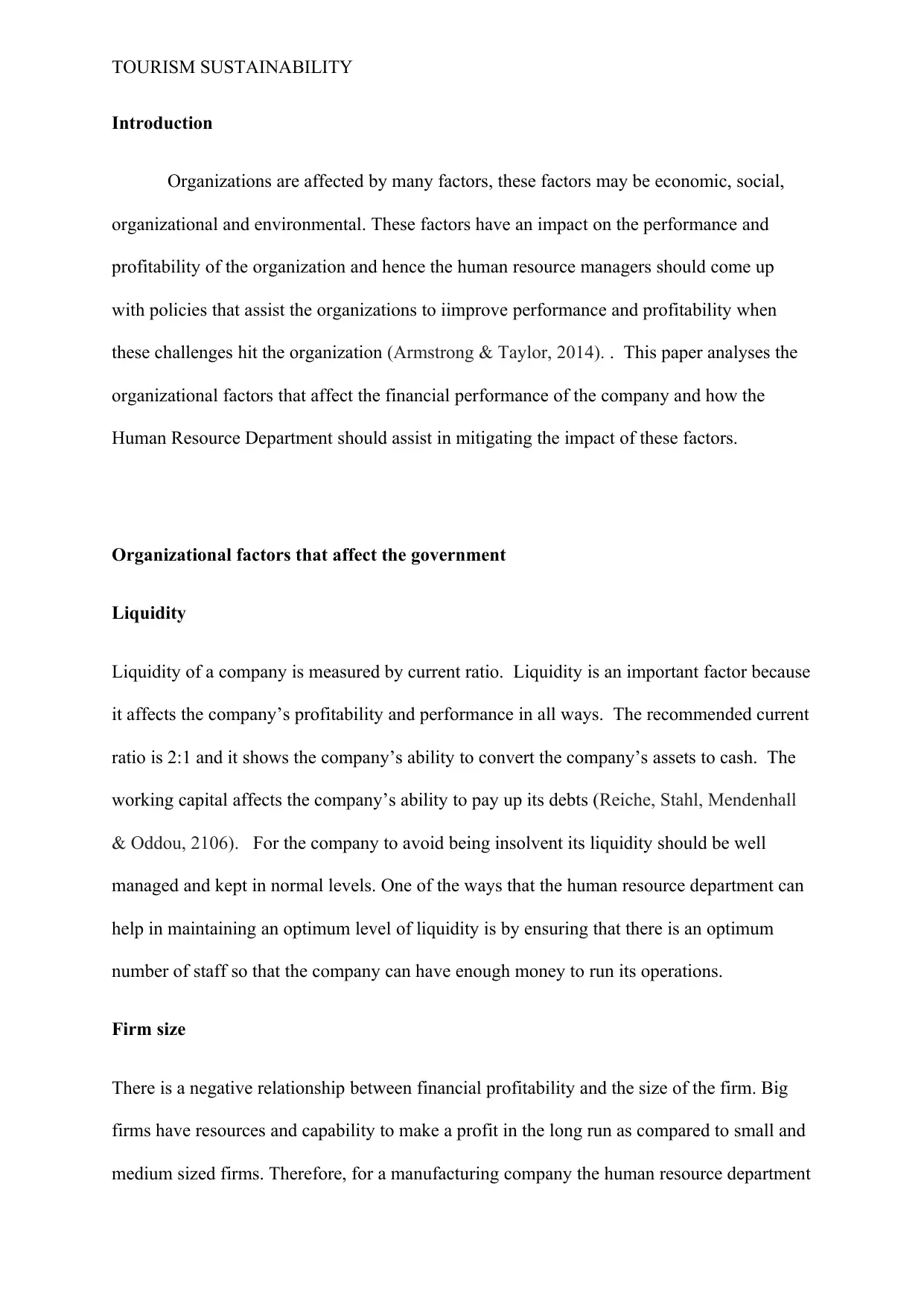
TOURISM SUSTAINABILITY
Introduction
Organizations are affected by many factors, these factors may be economic, social,
organizational and environmental. These factors have an impact on the performance and
profitability of the organization and hence the human resource managers should come up
with policies that assist the organizations to iimprove performance and profitability when
these challenges hit the organization (Armstrong & Taylor, 2014). . This paper analyses the
organizational factors that affect the financial performance of the company and how the
Human Resource Department should assist in mitigating the impact of these factors.
Organizational factors that affect the government
Liquidity
Liquidity of a company is measured by current ratio. Liquidity is an important factor because
it affects the company’s profitability and performance in all ways. The recommended current
ratio is 2:1 and it shows the company’s ability to convert the company’s assets to cash. The
working capital affects the company’s ability to pay up its debts (Reiche, Stahl, Mendenhall
& Oddou, 2106). For the company to avoid being insolvent its liquidity should be well
managed and kept in normal levels. One of the ways that the human resource department can
help in maintaining an optimum level of liquidity is by ensuring that there is an optimum
number of staff so that the company can have enough money to run its operations.
Firm size
There is a negative relationship between financial profitability and the size of the firm. Big
firms have resources and capability to make a profit in the long run as compared to small and
medium sized firms. Therefore, for a manufacturing company the human resource department
Introduction
Organizations are affected by many factors, these factors may be economic, social,
organizational and environmental. These factors have an impact on the performance and
profitability of the organization and hence the human resource managers should come up
with policies that assist the organizations to iimprove performance and profitability when
these challenges hit the organization (Armstrong & Taylor, 2014). . This paper analyses the
organizational factors that affect the financial performance of the company and how the
Human Resource Department should assist in mitigating the impact of these factors.
Organizational factors that affect the government
Liquidity
Liquidity of a company is measured by current ratio. Liquidity is an important factor because
it affects the company’s profitability and performance in all ways. The recommended current
ratio is 2:1 and it shows the company’s ability to convert the company’s assets to cash. The
working capital affects the company’s ability to pay up its debts (Reiche, Stahl, Mendenhall
& Oddou, 2106). For the company to avoid being insolvent its liquidity should be well
managed and kept in normal levels. One of the ways that the human resource department can
help in maintaining an optimum level of liquidity is by ensuring that there is an optimum
number of staff so that the company can have enough money to run its operations.
Firm size
There is a negative relationship between financial profitability and the size of the firm. Big
firms have resources and capability to make a profit in the long run as compared to small and
medium sized firms. Therefore, for a manufacturing company the human resource department
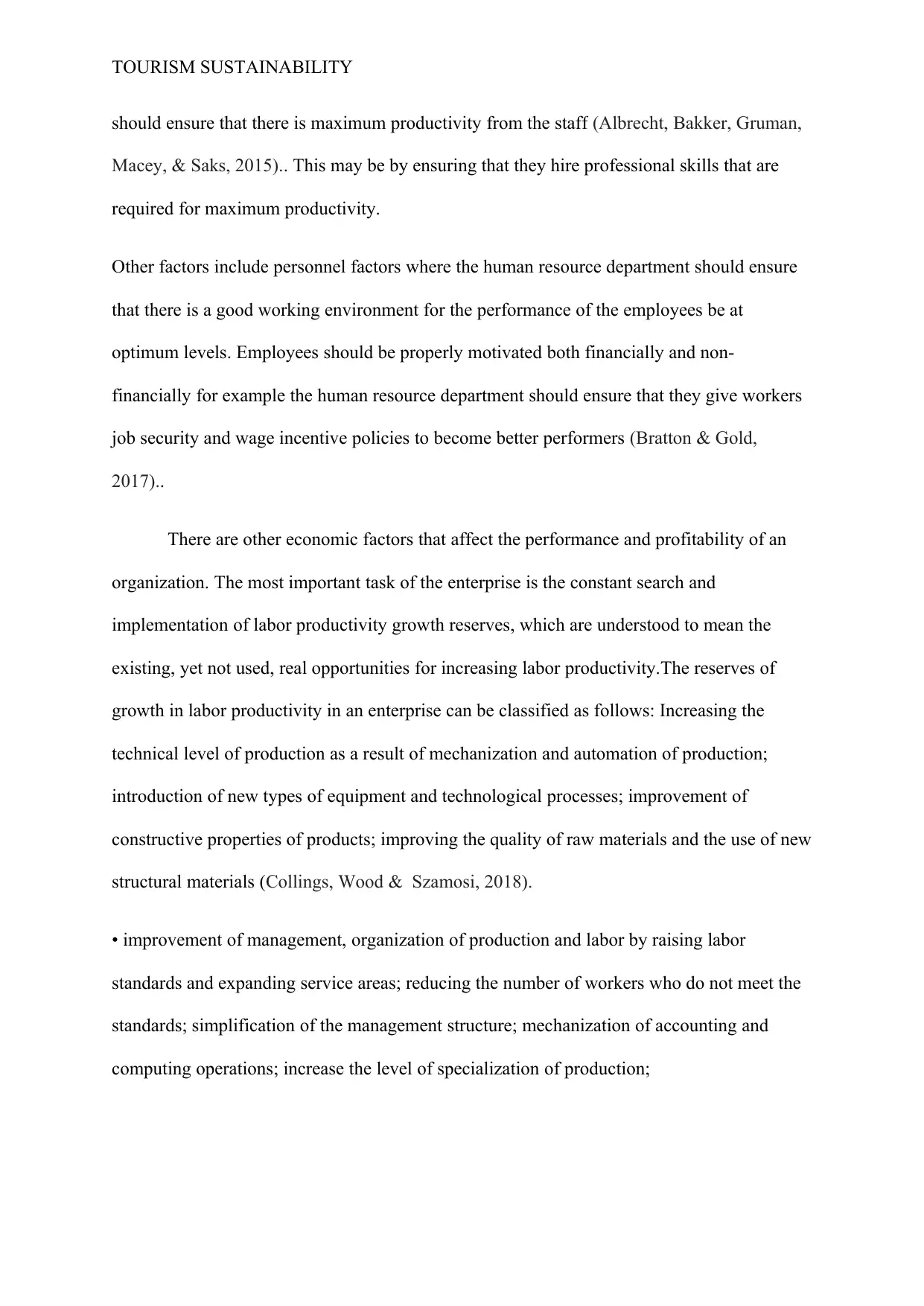
TOURISM SUSTAINABILITY
should ensure that there is maximum productivity from the staff (Albrecht, Bakker, Gruman,
Macey, & Saks, 2015).. This may be by ensuring that they hire professional skills that are
required for maximum productivity.
Other factors include personnel factors where the human resource department should ensure
that there is a good working environment for the performance of the employees be at
optimum levels. Employees should be properly motivated both financially and non-
financially for example the human resource department should ensure that they give workers
job security and wage incentive policies to become better performers (Bratton & Gold,
2017)..
There are other economic factors that affect the performance and profitability of an
organization. The most important task of the enterprise is the constant search and
implementation of labor productivity growth reserves, which are understood to mean the
existing, yet not used, real opportunities for increasing labor productivity.The reserves of
growth in labor productivity in an enterprise can be classified as follows: Increasing the
technical level of production as a result of mechanization and automation of production;
introduction of new types of equipment and technological processes; improvement of
constructive properties of products; improving the quality of raw materials and the use of new
structural materials (Collings, Wood & Szamosi, 2018).
• improvement of management, organization of production and labor by raising labor
standards and expanding service areas; reducing the number of workers who do not meet the
standards; simplification of the management structure; mechanization of accounting and
computing operations; increase the level of specialization of production;
should ensure that there is maximum productivity from the staff (Albrecht, Bakker, Gruman,
Macey, & Saks, 2015).. This may be by ensuring that they hire professional skills that are
required for maximum productivity.
Other factors include personnel factors where the human resource department should ensure
that there is a good working environment for the performance of the employees be at
optimum levels. Employees should be properly motivated both financially and non-
financially for example the human resource department should ensure that they give workers
job security and wage incentive policies to become better performers (Bratton & Gold,
2017)..
There are other economic factors that affect the performance and profitability of an
organization. The most important task of the enterprise is the constant search and
implementation of labor productivity growth reserves, which are understood to mean the
existing, yet not used, real opportunities for increasing labor productivity.The reserves of
growth in labor productivity in an enterprise can be classified as follows: Increasing the
technical level of production as a result of mechanization and automation of production;
introduction of new types of equipment and technological processes; improvement of
constructive properties of products; improving the quality of raw materials and the use of new
structural materials (Collings, Wood & Szamosi, 2018).
• improvement of management, organization of production and labor by raising labor
standards and expanding service areas; reducing the number of workers who do not meet the
standards; simplification of the management structure; mechanization of accounting and
computing operations; increase the level of specialization of production;
⊘ This is a preview!⊘
Do you want full access?
Subscribe today to unlock all pages.

Trusted by 1+ million students worldwide
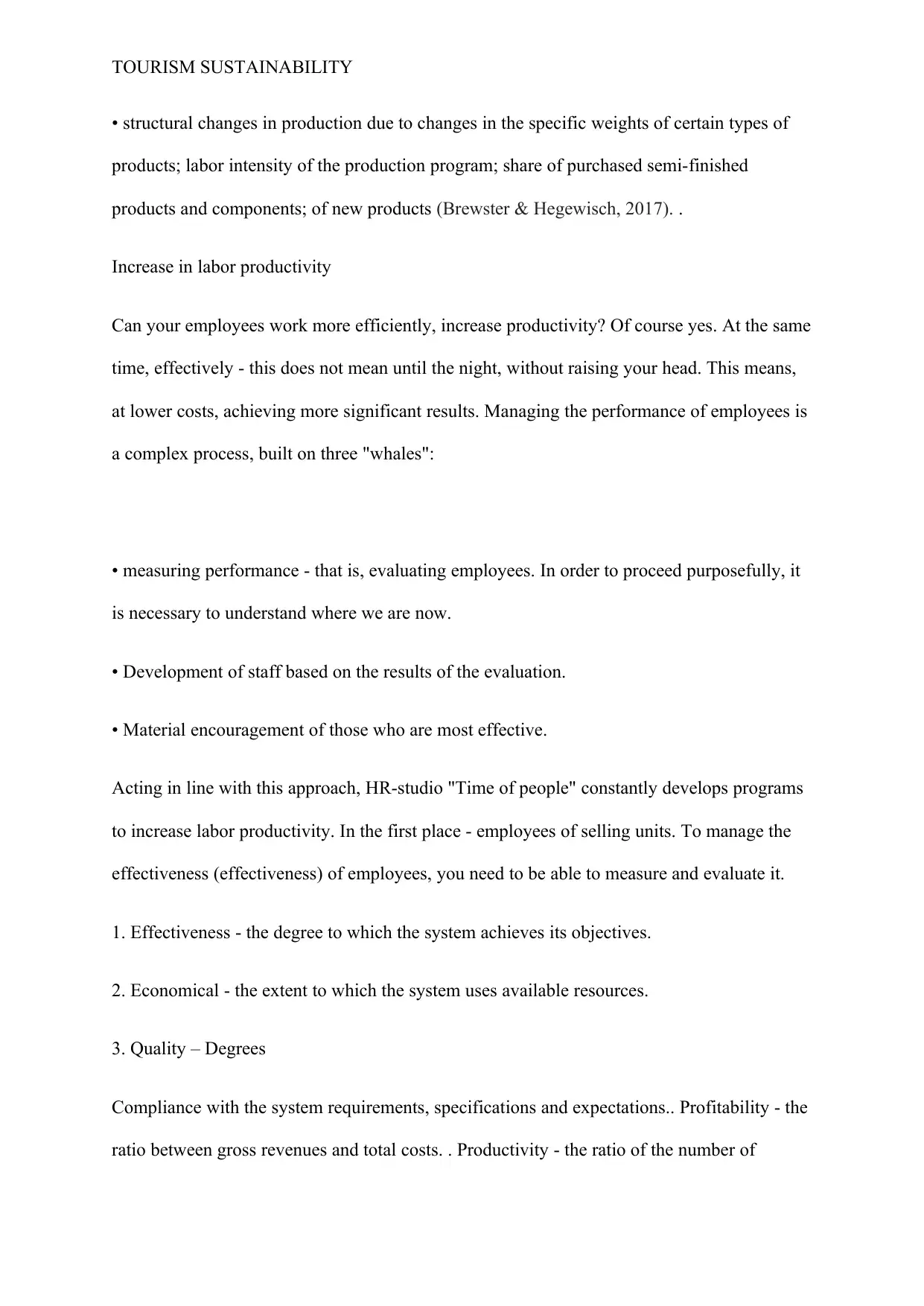
TOURISM SUSTAINABILITY
• structural changes in production due to changes in the specific weights of certain types of
products; labor intensity of the production program; share of purchased semi-finished
products and components; of new products (Brewster & Hegewisch, 2017). .
Increase in labor productivity
Can your employees work more efficiently, increase productivity? Of course yes. At the same
time, effectively - this does not mean until the night, without raising your head. This means,
at lower costs, achieving more significant results. Managing the performance of employees is
a complex process, built on three "whales":
• measuring performance - that is, evaluating employees. In order to proceed purposefully, it
is necessary to understand where we are now.
• Development of staff based on the results of the evaluation.
• Material encouragement of those who are most effective.
Acting in line with this approach, HR-studio "Time of people" constantly develops programs
to increase labor productivity. In the first place - employees of selling units. To manage the
effectiveness (effectiveness) of employees, you need to be able to measure and evaluate it.
1. Effectiveness - the degree to which the system achieves its objectives.
2. Economical - the extent to which the system uses available resources.
3. Quality – Degrees
Compliance with the system requirements, specifications and expectations.. Profitability - the
ratio between gross revenues and total costs. . Productivity - the ratio of the number of
• structural changes in production due to changes in the specific weights of certain types of
products; labor intensity of the production program; share of purchased semi-finished
products and components; of new products (Brewster & Hegewisch, 2017). .
Increase in labor productivity
Can your employees work more efficiently, increase productivity? Of course yes. At the same
time, effectively - this does not mean until the night, without raising your head. This means,
at lower costs, achieving more significant results. Managing the performance of employees is
a complex process, built on three "whales":
• measuring performance - that is, evaluating employees. In order to proceed purposefully, it
is necessary to understand where we are now.
• Development of staff based on the results of the evaluation.
• Material encouragement of those who are most effective.
Acting in line with this approach, HR-studio "Time of people" constantly develops programs
to increase labor productivity. In the first place - employees of selling units. To manage the
effectiveness (effectiveness) of employees, you need to be able to measure and evaluate it.
1. Effectiveness - the degree to which the system achieves its objectives.
2. Economical - the extent to which the system uses available resources.
3. Quality – Degrees
Compliance with the system requirements, specifications and expectations.. Profitability - the
ratio between gross revenues and total costs. . Productivity - the ratio of the number of
Paraphrase This Document
Need a fresh take? Get an instant paraphrase of this document with our AI Paraphraser
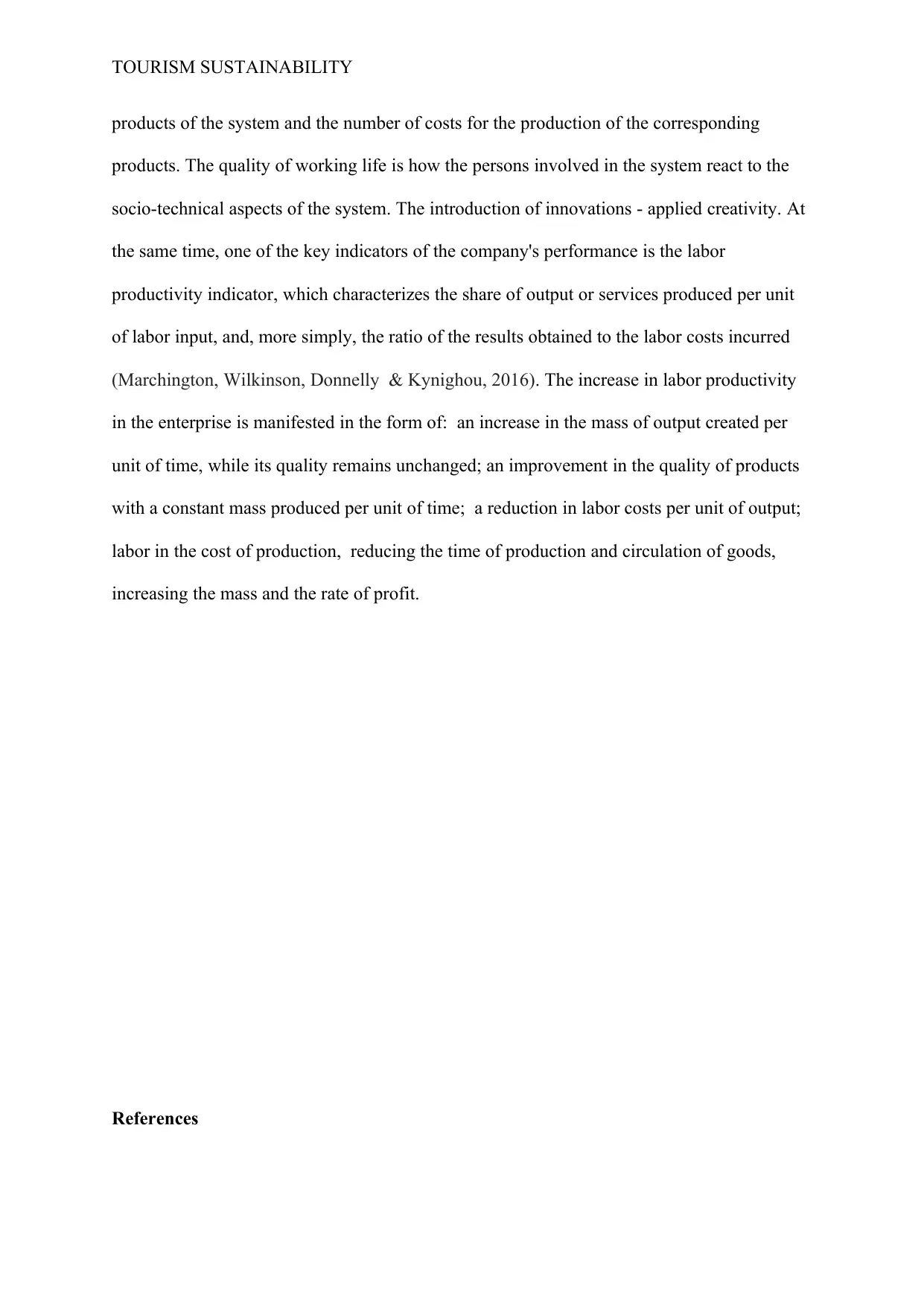
TOURISM SUSTAINABILITY
products of the system and the number of costs for the production of the corresponding
products. The quality of working life is how the persons involved in the system react to the
socio-technical aspects of the system. The introduction of innovations - applied creativity. At
the same time, one of the key indicators of the company's performance is the labor
productivity indicator, which characterizes the share of output or services produced per unit
of labor input, and, more simply, the ratio of the results obtained to the labor costs incurred
(Marchington, Wilkinson, Donnelly & Kynighou, 2016). The increase in labor productivity
in the enterprise is manifested in the form of: an increase in the mass of output created per
unit of time, while its quality remains unchanged; an improvement in the quality of products
with a constant mass produced per unit of time; a reduction in labor costs per unit of output;
labor in the cost of production, reducing the time of production and circulation of goods,
increasing the mass and the rate of profit.
References
products of the system and the number of costs for the production of the corresponding
products. The quality of working life is how the persons involved in the system react to the
socio-technical aspects of the system. The introduction of innovations - applied creativity. At
the same time, one of the key indicators of the company's performance is the labor
productivity indicator, which characterizes the share of output or services produced per unit
of labor input, and, more simply, the ratio of the results obtained to the labor costs incurred
(Marchington, Wilkinson, Donnelly & Kynighou, 2016). The increase in labor productivity
in the enterprise is manifested in the form of: an increase in the mass of output created per
unit of time, while its quality remains unchanged; an improvement in the quality of products
with a constant mass produced per unit of time; a reduction in labor costs per unit of output;
labor in the cost of production, reducing the time of production and circulation of goods,
increasing the mass and the rate of profit.
References
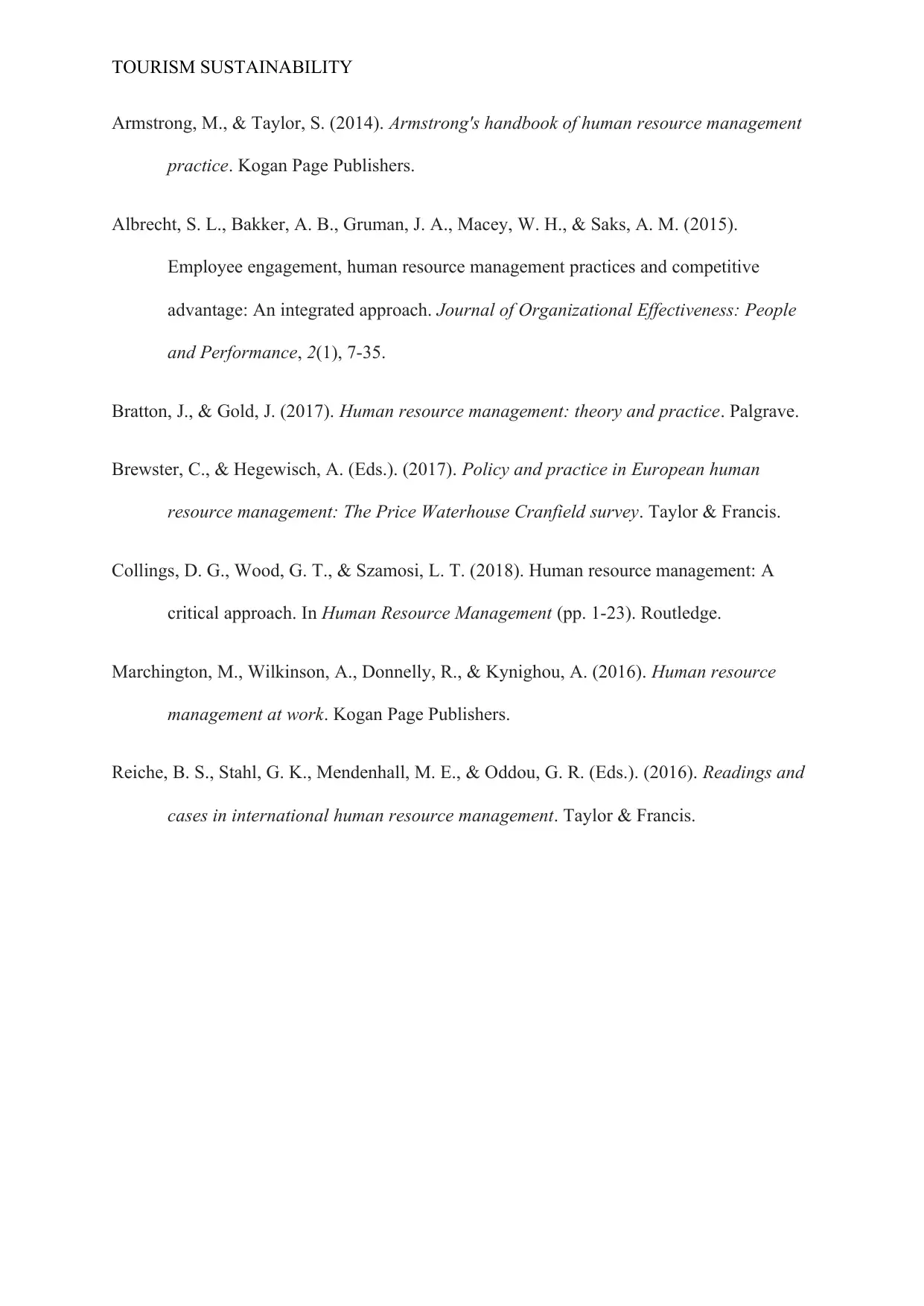
TOURISM SUSTAINABILITY
Armstrong, M., & Taylor, S. (2014). Armstrong's handbook of human resource management
practice. Kogan Page Publishers.
Albrecht, S. L., Bakker, A. B., Gruman, J. A., Macey, W. H., & Saks, A. M. (2015).
Employee engagement, human resource management practices and competitive
advantage: An integrated approach. Journal of Organizational Effectiveness: People
and Performance, 2(1), 7-35.
Bratton, J., & Gold, J. (2017). Human resource management: theory and practice. Palgrave.
Brewster, C., & Hegewisch, A. (Eds.). (2017). Policy and practice in European human
resource management: The Price Waterhouse Cranfield survey. Taylor & Francis.
Collings, D. G., Wood, G. T., & Szamosi, L. T. (2018). Human resource management: A
critical approach. In Human Resource Management (pp. 1-23). Routledge.
Marchington, M., Wilkinson, A., Donnelly, R., & Kynighou, A. (2016). Human resource
management at work. Kogan Page Publishers.
Reiche, B. S., Stahl, G. K., Mendenhall, M. E., & Oddou, G. R. (Eds.). (2016). Readings and
cases in international human resource management. Taylor & Francis.
Armstrong, M., & Taylor, S. (2014). Armstrong's handbook of human resource management
practice. Kogan Page Publishers.
Albrecht, S. L., Bakker, A. B., Gruman, J. A., Macey, W. H., & Saks, A. M. (2015).
Employee engagement, human resource management practices and competitive
advantage: An integrated approach. Journal of Organizational Effectiveness: People
and Performance, 2(1), 7-35.
Bratton, J., & Gold, J. (2017). Human resource management: theory and practice. Palgrave.
Brewster, C., & Hegewisch, A. (Eds.). (2017). Policy and practice in European human
resource management: The Price Waterhouse Cranfield survey. Taylor & Francis.
Collings, D. G., Wood, G. T., & Szamosi, L. T. (2018). Human resource management: A
critical approach. In Human Resource Management (pp. 1-23). Routledge.
Marchington, M., Wilkinson, A., Donnelly, R., & Kynighou, A. (2016). Human resource
management at work. Kogan Page Publishers.
Reiche, B. S., Stahl, G. K., Mendenhall, M. E., & Oddou, G. R. (Eds.). (2016). Readings and
cases in international human resource management. Taylor & Francis.
⊘ This is a preview!⊘
Do you want full access?
Subscribe today to unlock all pages.

Trusted by 1+ million students worldwide
1 out of 6
Related Documents
Your All-in-One AI-Powered Toolkit for Academic Success.
+13062052269
info@desklib.com
Available 24*7 on WhatsApp / Email
![[object Object]](/_next/static/media/star-bottom.7253800d.svg)
Unlock your academic potential
Copyright © 2020–2025 A2Z Services. All Rights Reserved. Developed and managed by ZUCOL.



